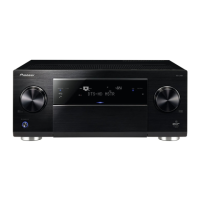128
Additional information
14
Auto Surround, ALC and Stream Direct with different input signal
formats
The following charts show what you will hear with different input signal formats, depending on the Stream Direct
mode (see Using Stream Direct on page 65 ) you have selected.
Stereo (2 channel) signal formats
Input signal format
Auto Surround /
DIRECT
ALC PURE DIRECT
Surround Back speaker(s): Connected
Dolby: 2.0 Surround
Dolby Digital Dolby Digital Dolby Digital
DTS Surround
Neo:X CINEMA
DTS
Neo:X CINEMA
Other stereo sources Stereo playback Stereo playback Stereo playback
Analog sources As above As above ANALOG DIRECT (stereo)
PCM sources As above As above Stereo playback
DVD-A sources As above As above As above
SACD sources As above As above As above
Surround Back speaker(s): Not connected
Dolby: 2.0 Surround
Dolby Digital Dolby Digital Dolby Digital
DTS Surround
Neo:X CINEMA
DTS
Neo:X CINEMA
Other stereo sources Stereo playback Stereo playback Stereo playback
Analog sources As above As above ANALOG DIRECT (stereo)
PCM sources As above As above Stereo playback
DVD-A sources As above As above As above
SACD sources As above As above As above
Multichannel signal formats
Input signal format Auto Surround / PURE DIRECT / DIRECT
Surround Back speaker(s): Connected
Dolby: Surround EX
Dolby Digital
Dolby TrueHD
<a>
DTS-HD Master Audio ES (6.1 channel flagged) DTS-ES (Matrix)
DTS-ES (6.1 channel sources/6.1 channel flagged) DTS-ES (Matrix/Discrete)
Other 5.1/6.1/7.1 channel sources Straight decoding
Surround Back speaker(s): Not connected
DVD-A sources/Multi-ch PCM Straight decoding
SACD sources (5.1 channel encoding) As above
Other 5.1/6.1/7.1 channel sources As above
a Unavailable with only one surround back speaker connected.
Speaker Setting Guide
In order to achieve an even better surround effect, it is important to accurately position the speakers and make
their volume and tone characteristics uniform so as to finely focus the multi-channel sound.
The three major elements in positioning the speakers are distance, angle and orientation (the direction in
which the speakers are pointing).
Distance: The distance of all the speakers should be equal.
Angle: The speakers should be horizontally symmetrical.
Orientation: The orientation should be horizontally symmetrical.
In most homes, however, it is not possible to achieve this environment. For the distance, on this receiver it is pos-
sible to automatically correct the speaker distance electrically to a precision of 1 cm using the Full Auto MCACC
Setup function (page 50 ).
Step 1: Speaker layout and distance adjustment
Use speaker stands or the like to make sure the speakers are steady, and leave at least 10 cm from the surround-
ing walls. Position the speakers attentively so that the speakers on the left and right are at equal angles from the
listening position (center of the adjustments). (We recommend using cords, etc., when adjusting the layout.)
Ideally all the speakers should be equidistant from the listening position.
Note
If the speakers cannot be set at equal distances (on a circle), use the Auto MCACC Setup speaker distance cor-
rection and Fine Speaker Distance functions to make them equalize the distance artificially.
Step 2: Adjusting the speaker height
Adjust the heights (angles) of the different speakers.
Adjust so that the front speaker units reproducing mid- and high frequencies is roughly at the height of the ears.
If the center speaker cannot be set at the same height as the front speakers, adjust its angle of elevation to point
it to the listening position.
Set surround speaker 1 so that it is not under the height of the ears.
Step 3: Adjusting the speaker orientation
If the left and right speakers are not pointing in the same direction, the tone will not be the same on the right
and left, and as a result the sound field will not be reproduced properly. However, if all the speakers are pointed
towards the listening position, the sound field will seem cramped. Testing by the Pioneer Multi-channel Research
Group has shown that a good sense of sound positioning can be achieved by pointing all the speakers towards an
area 30 cm to 80 cm behind the listening position (between the surround speakers and the listening position).
However, the sense of sound positioning can differ according to the conditions in the room and the speakers
being used. In smaller environments in particular (when the front speakers are close to the listening position),
with this method the speakers will be pointed too inward. We suggest you use this example of installation as
reference when trying out different installation methods.

